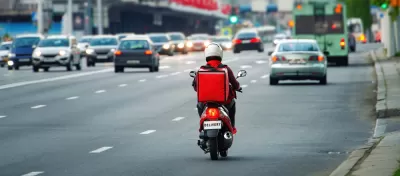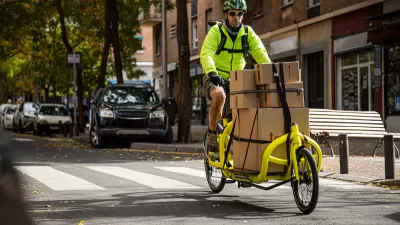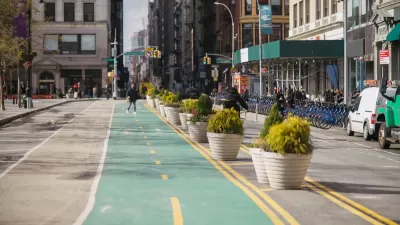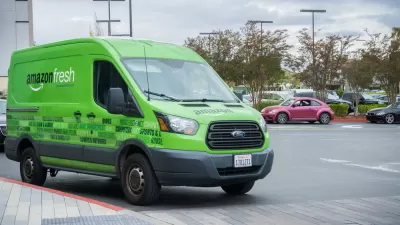Facilitating the use of micromobility devices for the last mile of urban deliveries can reduce congestion, lower emissions, and take bigger vehicles off small neighborhood roads.

A whitepaper commissioned by Uber describes the potential for micromobility to improve last-mile delivery of goods, which, for the most part, are currently delivered by cars and trucks. As reported by Charles Pekow in Smart Cities Dive, “Use of micromobility vehicles for those last-mile deliveries can bring a variety of benefits in urban areas — benefits some cities are already realizing, the whitepaper states.”
While these devices aren’t practical everywhere, the paper notes five strategies cities can implement to improve infrastructure for micromobility deliveries:
- Make micromobility users feel safe by taking Vision Zero and Safe Systems approaches to road infrastructure, regulations and communications.
- Facilitate safe and easy pick-up and drop-off of deliveries such as through curbside management strategies and building codes.
- Provide policy leadership in support of micromobility such as net zero emissions goals and innovation incubators.
- Support remoding of last-mile deliveries through micro-logistics hubs and other efforts.
- Test and scale ideas that work.
The article notes that bike delivery is nothing new, dating back more than a hundred years. “The whitepaper documents how other cities have successfully implemented bike delivery services. For example, after Toronto improved its cycling network, Uber Eats saw its bike deliveries in that city increase 40% from 2019 and 2020, Uber said. A 2019 project in New York City more than doubled cargo bike deliveries in the covered area, with each cargo bike that replaced a van or box truck resulting in about 7 tons fewer of annual CO2 emissions.”
FULL STORY: 5 strategies to advance micromobility for urban last-mile delivery: report

Study: Maui’s Plan to Convert Vacation Rentals to Long-Term Housing Could Cause Nearly $1 Billion Economic Loss
The plan would reduce visitor accommodation by 25,% resulting in 1,900 jobs lost.

North Texas Transit Leaders Tout Benefits of TOD for Growing Region
At a summit focused on transit-oriented development, policymakers discussed how North Texas’ expanded light rail system can serve as a tool for economic growth.

Why Should We Subsidize Public Transportation?
Many public transit agencies face financial stress due to rising costs, declining fare revenue, and declining subsidies. Transit advocates must provide a strong business case for increasing public transit funding.

How to Make US Trains Faster
Changes to boarding platforms and a switch to electric trains could improve U.S. passenger rail service without the added cost of high-speed rail.

Columbia’s Revitalized ‘Loop’ Is a Hub for Local Entrepreneurs
A focus on small businesses is helping a commercial corridor in Columbia, Missouri thrive.

Invasive Insect Threatens Minnesota’s Ash Forests
The Emerald Ash Borer is a rapidly spreading invasive pest threatening Minnesota’s ash trees, and homeowners are encouraged to plant diverse replacement species, avoid moving ash firewood, and monitor for signs of infestation.
Urban Design for Planners 1: Software Tools
This six-course series explores essential urban design concepts using open source software and equips planners with the tools they need to participate fully in the urban design process.
Planning for Universal Design
Learn the tools for implementing Universal Design in planning regulations.
City of Santa Clarita
Ascent Environmental
Institute for Housing and Urban Development Studies (IHS)
City of Grandview
Harvard GSD Executive Education
Toledo-Lucas County Plan Commissions
Salt Lake City
NYU Wagner Graduate School of Public Service





























